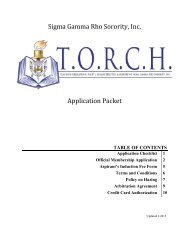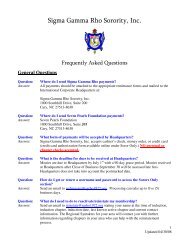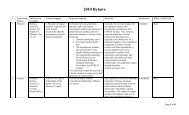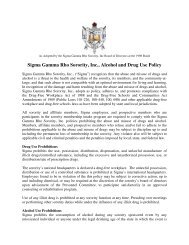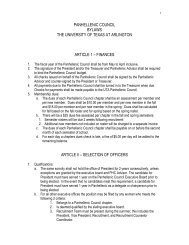They Stood Alone - Sigma Gamma Rho Sorority, Inc.
They Stood Alone - Sigma Gamma Rho Sorority, Inc.
They Stood Alone - Sigma Gamma Rho Sorority, Inc.
- No tags were found...
You also want an ePaper? Increase the reach of your titles
YUMPU automatically turns print PDFs into web optimized ePapers that Google loves.
Employee Stock OptionsSubmitted by:Lillie M. Hibbler-BrittBasileus, Beta Omicron <strong>Sigma</strong> ChapterMany employers offer their workers the chance to literally “own partof the company.”It’s good to have options.In this case, we’re talking about employee stock options, which many companies offer workers asa perk of employment. In a typical plan, management grants its workforce the right to buy stockat a specified price (the exercise price) by a certain time (the expiration date). In many cases, theopportunity to buy the stock extends for up to 10 years. If the company is doing well, the fair marketprice (the price of the stock on a securities exchange) could be above the exercise price, creatingprofit for the worker.“The attractiveness of an employee stock-option plan depends on the performance of the company,”says Angela Sheridan, Supervisor of ESOP/Restricted Stock Department of Wachovia Securities.“There could be a very large differential between the exercise price and the fair market price.” Afteran employee buys stock from the company, he or she is free to sell all or some of the shares througha financial advisor or brokerage company.Once management grants a stock-option package, vesting requirements vary, with some companiesallowing employees access to options immediately, while others might require a waiting period ofseveral years. Expiration periods are typically shortened after an employee leaves the company.In all cases, however, shares acquired through an employee stock-option plan remain the propertyof the employee.Taxing DifferencesThere are two types of employee stock-option plans. <strong>Inc</strong>entive stock options are usually reservedfor upper management, while nonqualified stock options may be available to all workers. Most ofthe differences between the two relate to taxes.In a nonqualified plan, tax is due in two installments. For instance, let’s assume you exercised yourright to buy 100 shares of the company’s stock at $50 per share on the same day that it is tradingat $75 per share. In that case, you would immediately owe income tax on a $2,500 gain. If you soldyour stock at $100 per share at least a year later, you would then pay tax at long-term capital-gainsrates (currently 15 percent) on the difference between the fair market price at the time of sale ($100)and the fair market value at the time of exercise ($75).With incentive options, all tax is deferred until the stock is actually sold. However, the alternativeminimum tax (AMT) often applies to sales of stock acquired through incentive plans. Participantsin incentive stock-option plans (also known as qualified plans) should consult their accountant tosee if the AMT applies to their situation.Winster/Spring 2008 • The Aurora 23




